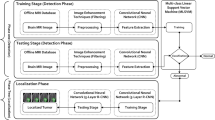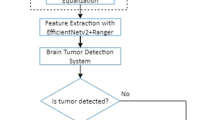Abstract
There are two types of brain tumors: benign and malignant. The quality of life and life expectancy of these patients are improved by early and timely disease detection and treatment plans. Utilizing deep neural networks is one of the most useful and significant techniques (DNN). In this study, brain magnetic resonance imaging (MRI) pictures were utilized to create a convolutional neural network (CNN) to identify a tumor. CNN was the first to use images. The classification accuracy of the soft max fully connected layer was 98.67%. Additionally, the decision tree (DT) classifier's accuracy is 94.24%, while the radial basis function (RBF) classifier's accuracy is 97.34%. We employ the standards of sensitivity, as well as the accuracy requirement, network performance is measured by specificity and precision. The network accuracy on the picture testing revealed that the soft max classifier has the highest accuracy in CNN, according to the data from the categorizers. This is a novel strategy for tumor detection from brain imaging that combines feature extraction methods with CNN. The method's predicted accuracy for the test data was 99.12%. The accuracy of the doctors’ assistance in diagnosing the tumor and treating the patient rose as a result of the significance of the diagnosis provided by the doctor (Vanitha in JAMA 216:109, 228, 2002 [Vanitha CN, Malathy S, Dhanaraj RK, Nayyar A (2022) Optimized pol- lard route deviation and routeselection using Bayesian machine learning techniques in wireless sensor networks. Comput Netw 216:109,228]).
Access this chapter
Tax calculation will be finalised at checkout
Purchases are for personal use only
Similar content being viewed by others
References
Vanitha CN, Malathy S, Dhanaraj RK, Nayyar A (2022) Optimized pol- lard route deviation and routeselection using Bayesian machine learning techniques in wireless sensor networks. Comput Netw 216:109,228
Malathy S, Vanitha CN, Narayan N, Kumar R, Gokul R (2021) An Enhanced Handwritten Digit Recognition Using Convolutional Neural Network. In: Memon et al. (eds) 2021 third international conference on inventive research in computing applications (ICIRCA). 2021 Third International Conference on Inventive Re- search in Computing Applications (ICIRCA). IEEE. Lamport certificateless signcryption deep neural networks for data aggregation se- curity in wsn. Intell Automat Soft Comput 33(3):1835–1847
Saravanakumar Pichumani TVP, Sundararajan P, Rajesh Kumar D, Yun- young N, Seifedine K (2021) Ruzicka indexed regressive homomorphic ephemeral key benaloh cryptography for secure data aggregation in WSN. J Int Technol 22(6):1287–1297
Dhanaraj RK, Ramakrishnan V, Poongodi M, Krishnasamy A, Vijaya-kumar V (2021) Random forest bagging and x-means clustered antipattern detection from SQL query log for accessing secure mobile data. In: Jain DK (ed) Wireless communications and mobile computing 2021:1–9
Deaton A, Zaidi S (2002) Guidelines for constructing consumption aggregates for wel- fare analysis. WorldBank 1–107
Vinod HD (1978) A survey of ridge regression and relatedtechniques for improvements over ordinary least squares. In: Hrishikesh D (eds) Vinod source: the review of economics and statistics 60:121–131 Published by: The MIT Pr. Rev Econ Stat. (1978) 60(1):121–31
Varian HR (2014) Big data: new tricks for econometrics. JEcon Perspect 28(2):3–28
Mullainathan S, Spiess J (2017) Machine learning: an appliedeconometric approach. J Econ Perspect 31(2):87–106
Dhanaraj RK, Lalitha K, Anitha S, Khaitan S, Gupta P, Goyal MK (2021) Hybrid and dynamic cluster based data aggregation and routing for wire-less sensor networks. J Intell Fuzzy Syst
Krishnamoorthi S, Jayapaul P, Dhanaraj RK et al (2021) Design of pseudo-random number generator from turbulence padded chaotic map. Nonlinear Dyn
Author information
Authors and Affiliations
Corresponding author
Editor information
Editors and Affiliations
Rights and permissions
Copyright information
© 2023 The Author(s), under exclusive license to Springer Nature Singapore Pte Ltd.
About this paper
Cite this paper
Singh, S.S., Kumar, R.R., Punia, S.K. (2023). Brain Tumor Detection Using Machine Learning. In: Fong, S., Dey, N., Joshi, A. (eds) ICT Analysis and Applications. ICT4SD 2023. Lecture Notes in Networks and Systems, vol 782. Springer, Singapore. https://doi.org/10.1007/978-981-99-6568-7_4
Download citation
DOI: https://doi.org/10.1007/978-981-99-6568-7_4
Published:
Publisher Name: Springer, Singapore
Print ISBN: 978-981-99-6567-0
Online ISBN: 978-981-99-6568-7
eBook Packages: Intelligent Technologies and RoboticsIntelligent Technologies and Robotics (R0)




